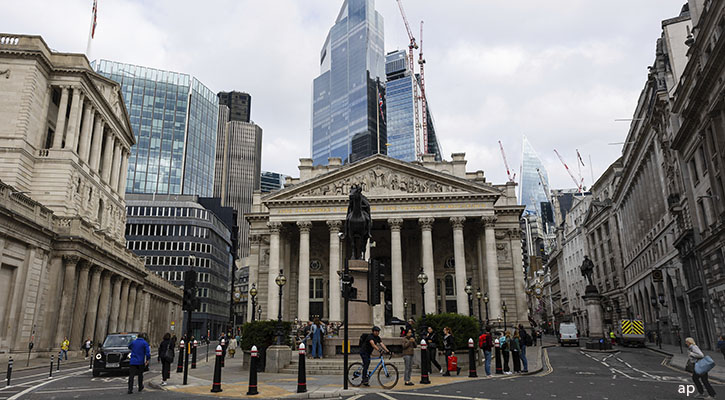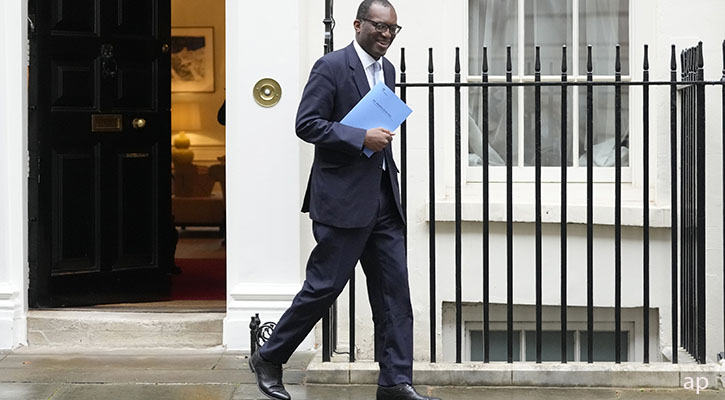
The crisis engulfing the UK government intensified on Wednesday after the Bank of England intervened in the bond market, buying long-dated gilts “to restore orderly market conditions” and end the “dysfunction” of the last few days. This move comes just days after the central bank stopped short of bringing in an emergency rate hike to calm both currency and bond markets.
Today’s intervention to buy £65 billion of government bonds over 13 days has had the intended effect of nudging down yields, which have soared since chancellor Kwasi Kwarteng’s mini-Budget on Friday, September 23. The benchmark 10-year gilt has dipped 23 basis points to 4.26% around Wednesday lunchtime, but is up 167 basis points this month alone and 327 bps over a year. That means the 10-year gilt has soared from yielding to 0.99% to 4.26% since last September.
The Bank’s statement on Wednesday referred to the “significant repricing of UK and global financial assets”, which has seen the pound hitting a record low against the dollar on Monday, and sizeable moves higher in UK gilt yields, which have hiked the government’s cost of borrowing and impacts on mortgage rates.
For Morningstar Invement Management CIO, EMEA, Mike Coop, the intervention can also be seen in positive terms: “Today’s news is a reminder that the UK has experience in dealing effectively with crises. We expect UK assets to continue to be buffeted by rising US and global rates, inflation concerns, rampant US dollar and investors turning from greedy to cautious and now fearful. Times like these present great buying opportunities for long term investors.”
Risk to Financial Stability
Why is the Bank intervening? It says there is a “material risk to UK financial stability” in the current market conditions, which could lead to “an unwarranted tightening of financial conditions and a reduction in the flow of credit to the real economy”. The Bank ruled out an imminent rate hike on Monday night, saying that its November meeting is likely to be the next opportunity for action, although it is monitoring the situation and is ready to step in. Since then, the Bank’s chief economist Huw Pill said a 100+ basis point move is likely at its next meeting.
From the government’s side, it is planning a “medium-term fiscal plan” on November 23. Markets movements are suggesting that waiting until November for the Bank and Treasury is going to be too late to stave off this current crisis.
The Bank has "blinked first" in the standoff between the chancellor and the central bank, according to Bethany Payne, global bonds portfolio manager, Janus Henderson, and from the market's point of view, it should have been the other way round. Still, today's move "should provide some comfort to investors that there is a gilt yield backstop", she says.
At the same time, the Bank "having to intervene to mitigate the damage done by the government is not a good look”, says Jim Leaviss, CIO of public fixed income at M&G.
How Will it Work?
Buying long-dated government bonds is “intended to tackle a specific problem in the long-dated government bond market”, the Bank said today, and auctions will run from today until October 14. “The purchases will be unwound in a smooth and orderly fashion once risks to market functioning are judged to have subsided,” it added. The purchases will amount to £5 billion a day over 13 days.
Earlier today the International Monetary Fund added its voice to those claiming the chancellor’s tax-cutting proposals are a mistake, calling on the Truss government to reverse these decisions before it’s too late. The pound fell to $1.07 after its comments were made public, and dropped further to $1.06 after the Bank of England’s move.
"We understand that the sizeable fiscal package announced aims at helping families and businesses deal with the energy shock and at boosting growth via tax cuts and supply measures,” the IMF said.
"However, given elevated inflation pressures in many countries, including the UK, we do not recommend large and untargeted fiscal packages at this juncture, as it is important that fiscal policy does not work at cross purposes to monetary policy.
"Furthermore, the nature of the UK measures will likely increase inequality."
The Background
In addition to today's operation, the Bank is temporarily pausing the sale of its £80 billion stock of government bonds, a process of unwinding that was supposed to start last week when it met to announce a 50 basis point rise in interest rates. A lot has happened since last Thursday. “The MPC’s annual target of an £80bn stock reduction is unaffected and unchanged. In light of current market conditions, the Bank’s Executive has postponed the beginning of gilt sale operations that were due to commence next week. The first gilt sale operations will take place on 31 October and proceed thereafter.”
Central banks over the world have in recent years been buying their government’s bonds in a process known as “Quantitative Easing”. They have been ready buyers of government debt, lowering borrowing costs for governments during a period when they have had to spend significant sums to support their economies through Covid.
The effect has been to lower borrowing costs for consumers too, but that process is now being reversed under “Quantitative Tightening”. Central banks like the Federal Reserve, Bank of England and European Central Bank have been hiking interest rates to combat spiralling inflation.
Why Do Government Bond Yields Go Up?
Yields go up because investors sell bonds, pushing down their prices. That can highlight a loss of confidence in the issuer’s economic strategy – for example, investors reacted strongly against a UK budget offering higher spending and tax cuts, a sort of financial vote of no confidence in the country’s outlook. Bond yields also reflect inflation and interest rate expectations.
The UK had previously been seen as a safe bet for bond investors but recent events suggest otherwise. Evangelia Gkeka, Morningstar’s senior manager research analyst, fixed income, says that the market is pricing in even further interest rates rises: “It seems that the market has the view that support measures will result in more government borrowing when borrowing costs are increasing and will further increase the debt to GDP and budget deficit, while also creating even higher inflation and the need to increase rates to a higher level than what is current projected, ultimately even potentially creating debt sustainability issues.” (my italics).






















